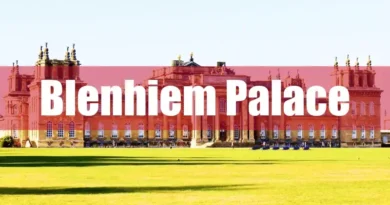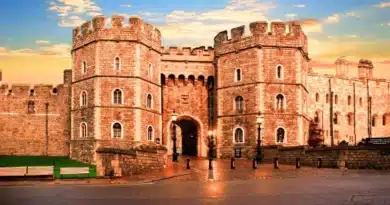The State Courtyard, Windsor Castle
Nestled within the majestic walls of Windsor Castle, the State Courtyard stands as a testament to British history and grandeur. This meticulously designed space, housing the State Apartments and other significant buildings, has been a grand stage for centuries for royal ceremonies, prestigious events, and state visits. From its architectural details to its exquisite art and decor, the State Courtyard offers a captivating glimpse into the heart of the British monarchy.
Key Takeaways
| Category | Key Takeaways |
|---|---|
| History & Significance | – Rectangular space with State Apartments on the north and east, Norman Gateway on the west, and an open south side. – State Apartments are the centrepiece, featuring grand halls, ornate ceilings, and large windows. – Norman Gateway (Tudor and Gothic blend) serves as the main entrance. – Central open space showcases manicured lawns and gravel pathways, used for ceremonies. |
| Architecture | – Rectangular space with State Apartments on the north and east, Norman Gateway on the west, and an open south side. – State Apartments are the centrepiece, featuring grand halls, ornate ceilings, and large windows. – Norman Gateway (Tudor and Gothic blend) serves as the main entrance. – Central open space showcases manicured lawns and gravel pathways, which are used for ceremonies. |
| Buildings | – State Apartments: Grand Staircase, Presence Chamber, Throne Room, Drawing Rooms, Nelson Room, Waterloo Chamber, St. George’s Hall, Grand Corridor. – Norman Gateway: Imposing entrance with twin towers and arrow slits. – Edward III Tower: Former royal apartments, now housing the Royal Library. – Henry VIII Gateway: Smaller, private entrance for the monarch in Tudor style. |
| Events | – State Ceremonies: Investitures of the Order of the Garter (highest knighthood in the UK). – Royal Weddings: Held in St. George’s Hall (e.g., Queen Victoria’s daughter’s wedding). – State Visits: Hosting foreign dignitaries with ceremonies and receptions. – Public Appearances: Balcony greetings by the Royal Family. |
| Art & Decor | – Paintings & Sculptures: Extensive collection depicting British monarchs throughout history (artists like Van Dyck and Lely). – Furniture: Period pieces reflecting different eras (Early Tudor dark oak, Georgian mahogany). – Tapestries: Woven with historical scenes, myths, and allegorical figures. |
| Legacy | – Powerful symbol of the British monarchy, reflecting centuries of tradition. – Imposing architecture and opulent decor reinforce the monarchy’s historical significance. |
Historical Significance and Architectural Overview of the State Courtyard

A. Historical Significance of the State Courtyard
The State Courtyard at Windsor Castle is of immense historical significance. Its story intertwines with the evolution of the British monarchy, serving as a grand stage for royal ceremonies, prestigious events, and state visits for centuries.
1. Early Development and Purpose:
The origins of the State Courtyard can be traced back to the 12th century during King Henry II’s reign. Following the construction of the Round Tower by King Henry I, Henry II embarked on a series of ambitious projects to transform Windsor Castle from a primarily military stronghold into a comfortable royal residence. This included the creation of an inner courtyard dedicated to showcasing the grandeur and power of the monarchy.
The earliest iteration of the State Courtyard likely consisted of a series of timber buildings surrounding a central open space. These buildings housed various royal apartments and reception halls.
2. Evolution of the Courtyard through Different Reigns:
Over the centuries, successive monarchs have left their mark on the State Courtyard. In the 14th century, King Edward III transformed the courtyard into a more formal and organised space. He constructed the core of the State Apartments, including the Great Hall (now known as St. George’s Hall) and the private apartments. These additions reflected the growing importance of Windsor Castle as a seat of government and a centre for diplomatic receptions.
Subsequent monarchs, like Charles II in the 17th century and George IV in the 19th century, undertook major renovations and embellishments of the State Courtyard. Inspired by French Baroque architecture, Charles II redesigned the State Apartments in a more opulent style. George IV, known for his extravagance, further transformed the courtyard into a dazzling showcase of British artistry. He commissioned renowned architects like Jeffry Wyatville to redesign the exterior facades and oversaw the creation of the lavish State Apartments we see today.
B. Architectural Overview of the State Courtyard
The State Courtyard, with its blend of architectural styles, reflects the rich tapestry of British history.
1. Design and Layout:
The State Courtyard is a rectangular space enclosed on three sides by buildings. The Norman Gateway, a fortified entrance with twin towers, forms the western boundary. The State Apartments, a sequence of grand halls and reception rooms, occupy the north and east sides. The southern side remains open, offering a view of the Lower Ward and the surrounding landscape.
2. Key Architectural Features:
- The State Apartments: These interconnected rooms are the architectural centrepiece of the courtyard. Each room boasts a distinct design, showcasing a variety of architectural styles from Gothic to Baroque. Notably, the State Apartments feature grand fireplaces, ornate plasterwork ceilings, and large windows that flood the rooms with natural light.
- The Norman Gateway: This imposing structure, with its round towers and arrow slits, serves as the main entrance to the State Courtyard. Despite its name, the gateway dates back to the reign of Henry VIII and represents a blend of Tudor and Gothic styles. The gateway’s imposing presence signifies the secure and prestigious nature of the enclosed space beyond.
- Courtyardscape: The central open space of the courtyard is adorned with manicured lawns and gravel pathways. During State ceremonies, this area is often used for military parades and presentations, adding to the grandeur.
A Detailed Look at the Buildings of the State Courtyard

The State Courtyard at Windsor Castle comprises significant buildings, each contributing to its rich architectural tapestry and historical significance. Here, we delve deeper into these structures, exploring their unique features and historical roles.
A. The State Apartments
The State Apartments, a sequence of interconnected and richly decorated rooms, form the heart of the State Courtyard. These grand halls served as a setting for royal ceremonies, official receptions, and private gatherings throughout British history. Let’s explore some of the most notable rooms:
1. Grand Staircase:
This magnificent staircase marks the entrance to the State Apartments. Designed by Jeffry Wyatville in the early 19th century, it features a sweeping double staircase with cast-iron railings and intricate stonework. Grand portraits of British monarchs adorn the walls, creating a sense of awe and setting the tone for the grandeur that lies ahead.
2. Presence Chamber:
This room served as an antechamber to the Throne Room. Here, guests would wait to be presented to the monarch. The Presence Chamber boasts a richly decorated ceiling and walls adorned with tapestries depicting scenes from British history.
3. Throne Room:
The heart of the State Apartments, the Throne Room, symbolises royal authority. This opulent space features a raised dais with two elaborate thrones traditionally reserved for the reigning monarch and their consort. The room is adorned with crimson velvet wall coverings, intricate gold leaf details, and magnificent chandeliers.
4-7. Crimson Drawing Room, Green Drawing Room, Blue Drawing Room:
These interconnected drawing rooms, each named for their dominant colour scheme, served as reception areas for smaller gatherings and less formal occasions. Each room showcases a distinct style: the Crimson Drawing Room features Chinese wallpaper and porcelain, the Green Drawing Room boasts Rococo-style furniture and portraits by Gainsborough, and the Blue Drawing Room displays a collection of Sevres porcelain and French tapestries.
8. Nelson Room:
This room, dedicated to Admiral Horatio Nelson, commemorates the British naval hero’s life and achievements. The walls are adorned with portraits of Nelson, battle scenes, and maritime artefacts.
9. Waterloo Chamber:
This grand hall celebrates the British victory at the Battle of Waterloo in 1815. The walls are lined with portraits of prominent figures from the battle, including the Duke of Wellington. Trophies and captured French eagles from the battle are also displayed here.
10. St. George’s Hall:
Originally known as the Great Hall, St. George’s Hall is the largest and most impressive room in the State Apartments. This magnificent hall, dating back to the 14th century, features a hammer-beam roof, stained glass windows, and a collection of heraldic shields. St. George’s Hall serves as a venue for grand ceremonies, including investitures of the Order of the Garter, a prestigious chivalric order of the British monarchy.
11. Grand Corridor:
This long corridor connects the various rooms of the State Apartments. The walls of the Grand Corridor are adorned with a vast collection of paintings, including works by Rubens, Van Dyck, and Canaletto.
B. Additional Buildings in the State Courtyard
While the State Apartments take centre stage, other significant buildings contribute to the architectural and historical character of the State Courtyard.
1. The Norman Gateway:
As mentioned earlier, this imposing structure serves as the main entrance to the courtyard. Although named after the Norman period, it dates back to the reign of Henry VIII and exemplifies a blend of Tudor and Gothic styles. The gateway’s twin towers and arrow slits evoke a sense of security and signify the prestigious nature of the enclosed space within.
2. The Edward III Tower:
Located on the northeast corner of the courtyard, this tower was built by King Edward III and served as private royal apartments. Today, it houses the Royal Library, which contains many historical documents, books, and manuscripts.
3. Henry VIII Gateway:
Situated on the eastern side of the courtyard, this smaller gateway provided a more private entrance for the monarch. Designed in the Tudor style, it features a portcullis and decorative brickwork.
The State Courtyard: A Stage for Royal Events

The State Courtyard at Windsor Castle transcends its architectural magnificence. It serves as a grand stage for various significant royal events, each contributing to the rich tapestry of British history and tradition.
A. State Ceremonies and Investitures
1. Investiture Ceremonies of the Order of the Garter:
Held annually on Garter Day (typically in June), the investiture ceremony of the Order of the Garter is one of the most prestigious events hosted in the State Courtyard. This chivalric order, established by King Edward III in 1348, is the highest order of knighthood in the United Kingdom. The ceremony, steeped in tradition, sees newly appointed Knights and Ladies Companion of the Garter formally invested by the Sovereign in the Throne Room. Following the inauguration, a procession of Knights and Ladies in their ceremonial robes takes place within the courtyard, adding to the grandeur of the occasion.
2. Royal Weddings:
The State Courtyard has witnessed several royal weddings throughout history. One notable example is the 1858 wedding of Queen Victoria’s eldest daughter, Princess Victoria, to Prince Frederick William of Prussia. The ceremony took place in the grand setting of St. George’s Hall, solidifying the international importance of the British monarchy.
B. State Visits and Receptions
1. Hosting Foreign Dignitaries:
The State Courtyard serves as a backdrop for welcoming and entertaining visiting Heads of State and foreign dignitaries. State visits involve official ceremonies, including military parades and receptions held within the courtyard. These events showcase British hospitality and diplomacy on a grand scale.
2. Public Appearances by the Royal Family:
On specific occasions, the State Courtyard becomes a platform for public appearances by the Royal Family. Balcony appearances, where members of the royal family greet crowds gathered in the courtyard below, are a cherished tradition. These events foster a sense of connection between the monarchy and the public.
The State Courtyard, with its rich history and symbolic grandeur, continues to be a vital stage for significant royal events. These events mark milestones in British history and contribute to the monarchy’s ongoing legacy.
Art and Decor in the State Courtyard

The State Apartments within Windsor Castle’s State Courtyard are adorned with a treasure trove of art and furnishings, enriching the space’s visual splendour. These elements offer a glimpse into the British monarchy’s artistic tastes and historical significance.
A. Paintings and Sculptures
The State Apartments boast an extensive collection of portraits, forming a historical record. These paintings range from early Tudor monarchs to more recent members of the Royal Family, tracing the lineage and evolution of the British monarchy. Confirmed artists represented include:
- Anthony van Dyck: A renowned 17th-century Flemish painter known for his portraits of royalty and aristocracy.
- Peter Lely: A 17th-century portraitist who was the principal painter to Charles I and Charles II of England.
B. Furniture and Tapestries
1. Period Furniture Styles:
The State Apartments showcase exquisite furniture pieces from various periods, reflecting the evolving tastes and craftsmanship throughout British history.
- Early Tudor furniture: Crafted from dark oak, these pieces are likely to be found in some rooms, representing the prevailing style of the 16th century.
- Georgian mahogany pieces: The elegance of Georgian-era furniture (18th-19th centuries) is likely present in other rooms, with mahogany being a popular choice during this period.
2. Tapestries:
Tapestries are an integral part of the decorative scheme, woven with intricate details and vibrant colours. These tapestries depict historical scenes, mythological stories, and allegorical figures, enriching the historical context of each room. Specific monarchs commissioned many tapestries, although confirming individual names might require further research.
The meticulously curated art and decor within the State Courtyard contribute to the overall grandeur and narrative of the British monarchy. The collection not only showcases artistic excellence but also offers a fascinating glimpse into the past through the styles and choices of previous monarchs.
The State Courtyard: Symbol and Legacy
The State Courtyard, with its impressive architecture and rich artistic heritage, stands as a powerful symbol of the British monarchy. Its enduring presence reflects centuries of tradition and the ongoing legacy of the Crown. Elements like the imposing Norman Gateway and opulent Throne Room contribute to a sense of awe and grandeur, reinforcing the monarchy’s historical significance.










Comments are closed.